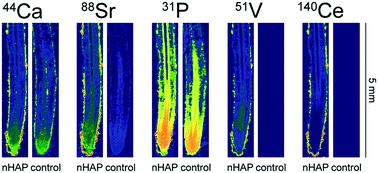当前位置:
X-MOL 学术
›
Environ. Sci.: Nano
›
论文详情
Our official English website, www.x-mol.net, welcomes your feedback! (Note: you will need to create a separate account there.)
Unravelling the interactions between nano-hydroxyapatite and the roots of phosphorus deficient barley plants
Environmental Science: Nano ( IF 7.3 ) Pub Date : 2020-11-24 , DOI: 10.1039/d0en00974a Augusta E. Szameitat 1, 2, 3, 4 , Anurag Sharma 1, 2, 3, 4 , Francesco Minutello 1, 2, 3, 4 , Andrea Pinna 1, 2, 3, 4 , Meriem Er-Rafik 4, 5, 6, 7 , Thomas H. Hansen 1, 2, 3, 4 , Daniel P. Persson 1, 2, 3, 4 , Birgit Andersen 1, 2, 3, 4 , Søren Husted 1, 2, 3, 4
Environmental Science: Nano ( IF 7.3 ) Pub Date : 2020-11-24 , DOI: 10.1039/d0en00974a Augusta E. Szameitat 1, 2, 3, 4 , Anurag Sharma 1, 2, 3, 4 , Francesco Minutello 1, 2, 3, 4 , Andrea Pinna 1, 2, 3, 4 , Meriem Er-Rafik 4, 5, 6, 7 , Thomas H. Hansen 1, 2, 3, 4 , Daniel P. Persson 1, 2, 3, 4 , Birgit Andersen 1, 2, 3, 4 , Søren Husted 1, 2, 3, 4
Affiliation

|
The recent introduction of nanotechnology in plant science has paved the way for the development of more efficient fertilizers. However, progress in research is currently hampered by a poor understanding of the interactions between nanomaterials and plant tissue. The present study investigates the potential of nano-hydroxyapatite (nHAP) as a phosphorus (P) fertilizer and the mechanisms involved during plant utilization of such nanoparticles. Using a combination of techniques to assay P functionality in metabolism and for bioimaging of P with cellular resolution, we demonstrate that contact between citrate-stabilized nHAP and roots of P deficient barley plants (grown hydroponically for 21 days) leads to a significant increase in leaf P concentration (from <2000 to >6000 ppm) and to a subsequent restoration of plant P functionality in less than 48 hours. Within the first 24 hours, intact nHAP adheres to the root epidermis without dissolving. Within the following 24 hours, nHAP penetrates the roots through the apoplast of mature epidermal and cortical cells, and dissolve here due to the acidic environment of the cell wall matrix. The mucilage layer surrounding the root cap prevents, in this specific region, the entrance of nHAP, which gradually dissolves without penetrating into deeper cell layers. In parallel, we investigate citrate-stabilized nano-rock phosphate (nRP), and demonstrate that it possesses equivalent plant bioavailability as synthetic nHAP. Since nRP was prepared through simple mechanical grinding of mined and flotated rock phosphate, this underlines its potential for direct use in agriculture, provided that contact between root tissue and nanoparticles is established. Overall, the results provide the first mechanistic evidence showing how nutrient deficient plants interact with intact nanoparticles to restore functionality in metabolism.
中文翻译:

揭示纳米羟基磷灰石与缺磷大麦植物根系之间的相互作用
纳米技术最近在植物科学中的应用为开发更高效的肥料铺平了道路。但是,目前对纳米材料与植物组织之间相互作用的了解不足,阻碍了研究的进展。本研究调查了纳米羟基磷灰石(nHAP)作为磷(P)肥料的潜力及其在植物利用此类纳米颗粒过程中涉及的机制。使用多种技术组合测定代谢中的P功能以及对P进行细胞成像的生物成像,我们证明柠檬酸稳定的nHAP与P缺乏的大麦植物根部(水培生长21天)之间的接触会导致叶片显着增加磷浓度(<2000至> 6000 ppm),然后在不到48小时内恢复工厂P的功能。在最初的24小时内,完整的nHAP粘附在根表皮上而不溶解。在接下来的24小时内,nHAP通过成熟的表皮和皮质细胞的质外体穿透根部,并由于细胞壁基质的酸性环境而在此处溶解。根冠周围的粘液层可在此特定区域阻止nHAP的进入,后者逐渐溶解而不会渗透到更深的细胞层中。同时,我们研究了柠檬酸盐稳定的纳米岩石磷酸盐(nRP),并证明它具有与合成nHAP相当的植物生物利用度。由于nRP是通过对矿山和浮选的磷酸盐岩进行简单的机械研磨而制备的,因此这突出了其直接用于农业的潜力,只要在根组织和纳米颗粒之间建立了接触即可。总体而言,结果提供了第一个机制证据,显示了营养不足的植物如何与完整的纳米颗粒相互作用以恢复代谢功能。
更新日期:2020-12-17
中文翻译:

揭示纳米羟基磷灰石与缺磷大麦植物根系之间的相互作用
纳米技术最近在植物科学中的应用为开发更高效的肥料铺平了道路。但是,目前对纳米材料与植物组织之间相互作用的了解不足,阻碍了研究的进展。本研究调查了纳米羟基磷灰石(nHAP)作为磷(P)肥料的潜力及其在植物利用此类纳米颗粒过程中涉及的机制。使用多种技术组合测定代谢中的P功能以及对P进行细胞成像的生物成像,我们证明柠檬酸稳定的nHAP与P缺乏的大麦植物根部(水培生长21天)之间的接触会导致叶片显着增加磷浓度(<2000至> 6000 ppm),然后在不到48小时内恢复工厂P的功能。在最初的24小时内,完整的nHAP粘附在根表皮上而不溶解。在接下来的24小时内,nHAP通过成熟的表皮和皮质细胞的质外体穿透根部,并由于细胞壁基质的酸性环境而在此处溶解。根冠周围的粘液层可在此特定区域阻止nHAP的进入,后者逐渐溶解而不会渗透到更深的细胞层中。同时,我们研究了柠檬酸盐稳定的纳米岩石磷酸盐(nRP),并证明它具有与合成nHAP相当的植物生物利用度。由于nRP是通过对矿山和浮选的磷酸盐岩进行简单的机械研磨而制备的,因此这突出了其直接用于农业的潜力,只要在根组织和纳米颗粒之间建立了接触即可。总体而言,结果提供了第一个机制证据,显示了营养不足的植物如何与完整的纳米颗粒相互作用以恢复代谢功能。



























 京公网安备 11010802027423号
京公网安备 11010802027423号